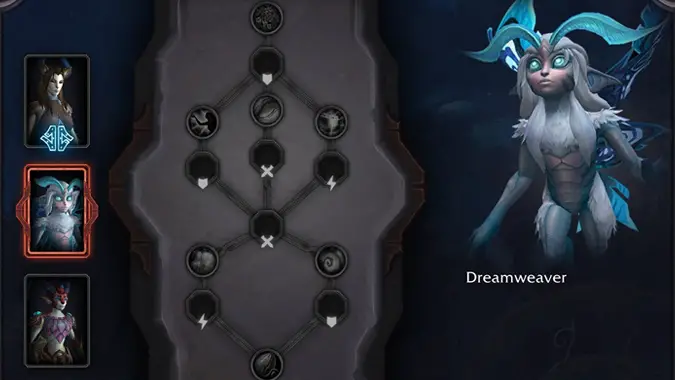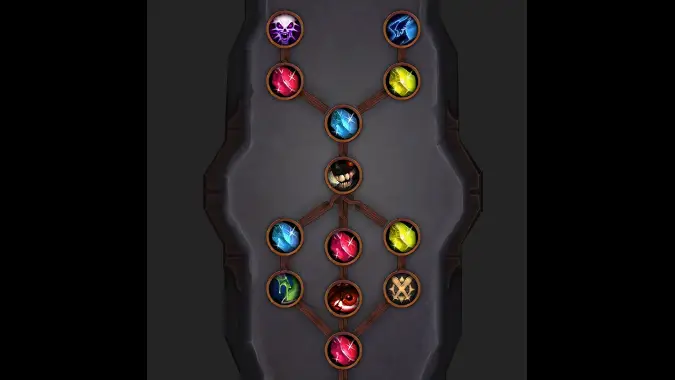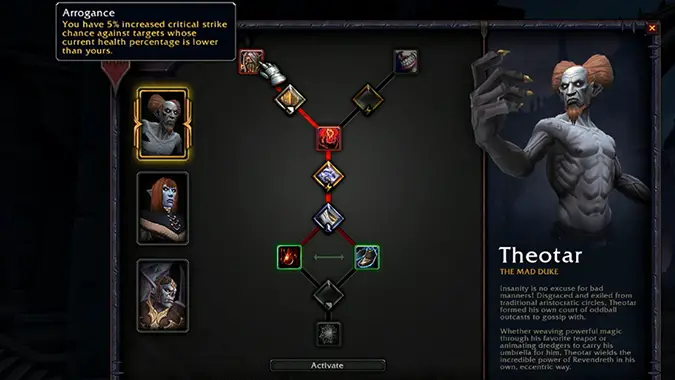Soulbind Conduits show that Blizzard has learned from the mistakes of Azerite Armor

After getting a first look at the Soulbind and Conduit system in Shadowlands, I had some apprehensions, because it shares many of the same mechanics that plagued Battle for Azeroth’s Azerite Armor. Conduits provide buffs that are specific to your specialization, but they remain in place when you swap specs, much like spec-specific Azerite traits. You can replace your Conduit, but when you do, the old one you had is destroyed, kind of like a gem.
Those are legitimate concerns especially for playing multiple specializations. Battle for Azeroth eventually introduced an Azerite Reforger to address this problem with Azerite, letting you reset your traits to something that suited another spec — but there’s no Reforger for Conduits in Shadowlands. If you want to change them, you have to destroy them and replace them.
Is Shadowlands just trading out one multispec-unfriendly system for another? Not as much as you might think, because Blizzard has learned a few lessons from the Azerite Armor and the Heart of Azeroth systems. The Conduit system does pose some challenges for multispec players, but there are already systems in place to mitigate those challenges.
Let’s dive a little deeper into the Soulbind and Conduit system to find out just how they’ll work, particularly for multispec players.

How do Conduits even work?
Conduits are part of the larger Soulbind system. Soulbinds are three special NPCs from your chosen Covenant that become closer than family to you during your adventures. Each one gives you access to a unique talent tree, like the one you had with your Heart of Azeroth or your Artifact back in Legion. As you work your way through the Soulbind tree, you’ll activate Traits and Conduits.
Traits are intrinsic parts of the Soulbind tree: they’re fixed and don’t change. But Conduits are flexible. You’ll earn different Conduits and choose which ones to socket into the tree as you go.
I say socket because, graphically, Conduits look just like colored gems. They come in three colors — blue, red, or yellow — that represent the type of Conduit:
- Red: Throughput
- Blue: Utility
- Yellow: Survival
You’ll match the color of the Conduit to the color of the Conduit slot in the Soulbind tree. It’s just like putting a gem in your gear.
How do you get Conduits?
How much of a problem this is will depend on how easy it will be to get Conduits. Gems are relatively plentiful and, aside from the very best gems, pretty affordable — but we don’t really know how we’ll get Conduits.
Wowhead has been told that Conduits “won’t be awarded exactly like relics which competed with drops on loot tables.” Ketsuki from Wowhead told me that “Conduits will drop in places that loot is dropped. While it may not be on a boss loot table it will be in places that loot can drop so either dungeons, open world, etc.” But we don’t know how common Conduit drops will be, or if this is the only way to get them.
There’s also the possibility we’ll be using a more deterministic system of acquiring them like Renown, or a Shadowlands equivalent of a currency like Echoes of Ny’alotha. We could even see a good old Reputation grind. If they’re simply purchasable, they would be pretty easy to replace — as soon as you unlock whatever requirements are needed to buy them.

Here’s how Conduits and Soulbinds work in practice
All of the above is pretty abstract, so let’s take a specific a look at one Soulbind tree: Nadjia the Mistblade of the Venthyr. That’s her tree in the image above. All the colored gems you see are Conduit sockets.
Right off the bat, you have to choose between the Traits of Agent of Chaos and Fancy Footwork, both of which enhance the Venthyr Covenant ability Door of Shadows in a unique way. Depending on which one you choose, you’ll empower a different Conduit socket: Agent of Chaos leads to a red Throughput Conduit while Fancy Footwork leads to a yellow Survival Conduit.
Let’s say you’re a Druid, one of the few classes with Conduits implemented in the alpha. If you’re a Bear tank for your group, you might want the Survival Conduit because you can socket Steel Leaves for a nice boost to your Barkskin. If you’re a Boomkin, you’ll probably be drawn to the Throughout Conduit to socket Trinary Efflux to increase your Starsurge damage. Both paths meet back at a blue Utility Conduit where you could put the Continuing Stampede Conduit.
Nadijia has two more Conduits in her tree. The tree splits again and you you have to choose between a Survival, Utility, or Throughput Conduit, and at the bottom of the tree you have a red Throughput Conduit.
DPS players will probably go with a build that gives them three red Throughput Conduits and one blue Utility Conduit. You could call this a 3R1B build, which sounds like a Star Wars droid. A tank or healer might have a build with two yellow Survival Conduits, one red Throughput Conduit and one blue Utility Conduit. A 2Y1R1B build.
General Draven, a different Venthyr Soulbind, has several possible builds, all different from Nadijia. In his tree, you can make builds like 3Y1R, 2Y2R, 1Y1R2B, and many more.
Now that we know how Soulbinds and Conduits work, we can look at how they integrate with multiple specs.

Am I locked in to a specific spec once I socket my Conduits?
Imagine for a moment you’re a Retribution Paladin. All of your Conduits are perfectly set up for maximum DPS. You log in one night and your group’s healer has gotten sick. They need you to step in, but your that Conduits are spec specific. How badly will your lack of Holy Conduits hurt you?
The answer is a solid we don’t know, but there are several aspects to this system which make it easier to swap specs than I initially thought.
You can respec your Soulbind for a low cost
Each Soulbind tree has multiple paths. For your DPS spec, you spec Nadjia 3R1B (three Throughput and one Utility). When you switch to Resto, you can spend a relatively inexpensive reagent — a Tome of Clear Mind — and respect Nadjia to 2Y1R1B (two Survival, one Throughput and one Utility). Any Conduits you have socketed will remain and are not destroyed, but they go inactive until you activate that node again.
You can switch Soulbinds for no cost
Changing from one Soulbind to the other doesn’t event cost a reagent: it’s a simple button press.
According to the official Soulbinds preview, “You can choose between Soulbinds in rested areas or with a Tome of the Clear Mind or Codex of the Clear Mind to vary your play style for the battle ahead. Soulbind traits and Conduits can only be changed at the Forge of Bonds, located inside your Covenant Sanctum.”
Each Convenant has three Soulbinds. Most classes have three specs. That numeric match can’t be a coincidence. The Venthyr have Nadjia the Mistblade, General Draven, and Theotar the Mad Duke for Soulbinds. You could set up Draven with your tanking Conduits, Nadjia with your DPS Conduits, and Theotar with healing Conduits. Or maybe Draven gets all your AOE Conduits for Mythic Plus while Theotar gets all your single-target Conduits for raid bosses.
Whether you’re respecing your Soulbind or switching Soulbinds, you have to be in your Covenant’s Sanctum to activate new nodes on your Soulbind tree or socket new Conduits. This is similar to how you have to be at the Heart Forge to socket in new Essences or unlock new Heart of Azerite traits. It’s a small inconvenience, but once you have your Soulbind trees unlocked and configured, it won’t stop you from easily swapping Soulbinds.
You can play the class, not the spec
Part of the overall class design philosophy of Shadowlands is a greater emphasis on your class than your spec. All Warriors are tanky to a degree. All Paladins have healing as part of their kit. Druids have a little bit of everything.
Because classes share more features than they used to, not having a perfect setup may not be a a big problem. Less than optimal Conduits might not make or break your ability to perform the role as much as they would in Battle in Azeroth, which still has the remnants of Legion’s hyper-focus on spec.
Some Conduits have multispec potential
Though we don’t know if these will ever go live, there are datamined Conduits that do different things depending on what spec you’re in. These include things like Stalwart Guardian for Warrior or Master of Shapes for Druid. Using these kinds of Conduits creates greater flexibility in your builds, letting you swap between roles more easily.

Blizzard has learned lessons from Azerite Armor
When I first heard that you could only replace a Conduit by destroying a Conduit and that socketed Conduits would remain when swapping specs, I was not enthusiastic about the system. These mechanics would make it hard on anyone trying to run more than one spec. I wasn’t a fan.
But after taking a deeper look into the system, I have to admit, I was wrong. The WoW team has learned many lessons from Azerite Armor and the Heart of Azeroth. They’ve developed a far more robust and flexible system this time around. Switching Soulbinds is likely the intended solution and someone will probably write an addon that switches your Soulbind when you switch specs just like how there are addons that switch your gear when you switch your spec.
Thanks to the lessons learned from Battle for Azeroth, running multiple specs in Shadowlands won’t be near the hassle I thought it might be.
Please consider supporting our Patreon!
Join the Discussion
Blizzard Watch is a safe space for all readers. By leaving comments on this site you agree to follow our commenting and community guidelines.
 @honorshammer
@honorshammer



